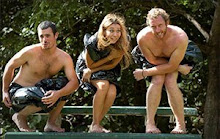 Image from Guardian.co.uk
Image from Guardian.co.ukWith news of the Victorian Bushfires dominating the news and views of the whole of Australia for most of February, it was with incredulity and awe that we listened to it all. The great extremes of the climate produced by this continent were asserting themselves dramatically. As we were experiencing the Wet season in the Top End, and the mighty river systems rose and flowed in flood and deluge, with creeks torrential and the floodplains vast, in the south of the country, in Victoria, they were having the worst, the most destructive and devastating Bushfires in Australian history.
Around the same time in Ingham, on Queensland's coast, the rain fell uninterrupted for 33 straight days, flooding many out of their homes, and drowning the crops the farmers rely on for their living. Not a drop of this vast deluge touched the southern end of the island, instead a drought, that had been constant for nearly seven years, culminated this year in record temperatures soaring into the mid-forties as a scorching heat-wave sent the state of Victoria into full alert; residents were warned of the potential for Bushfires; the bone-dry dense scrub surrounding the populated areas was like tinder, and coupled with high winds gusting through, a state-wide fire ban was called and extreme caution urged.

When the first fires broke out, some, we found out later, deliberately, they erupted and consumed and burnt with an intensity that no one anticipated. Black Saturday, February 7th, saw more than four hundred bushfires variously burning with degrees of ferocity as the wind fanned and spread the flames. The policies towards Bushfires propose that citizens in the path of one choose one of two options: to escape and take with you what you can, or to stay, prepare a defence, and fight. The fires were so intense and furious that some people had neither time nor warning to do either. 120 people died that day alone.
Over 175 people died all told, more than 500 injured, over 3,500 buildings were razed completely, with damage to thousands more. Entire communities were burnt to a cinder, the bodies of families trying to flee the inferno were found in their cars, still in their driveway, unable to escape in time. Those that survived talked of a 'Tsunami of fire' that roared through the hillside, hurled along by 100 kilometre and hour winds, giving those that had made all the proper preparations to protect their homes no opportunity to as much as think of defending themselves. Fire-breaks were rendered useless, new fires erupted from the smouldering ash, igniting the dense layers of scrub, as firemen backtracked and worked furiously trying to contend with it all, and as the wind threw it along.
Listening to the reports as they came in on the radio, we were horrified to learn of the carnage, as daily it got worse. More fires started as the wind carried with it spark and cinder, fanning the blaze over large distances and areas. It was terrible. Utter helplessness and total loss followed in its wake as home after home and family after family were affected. The series of fires consumed many towns north-east of the state capital Melbourne and most were badly damaged or almost completely destroyed - Kinglake, Marysville, Narbethong, Strathewen and Flowerdale among those towns that no longer exist. The fires affected 78 individual townships in total and left an estimated 7,500 people homeless.
Those unaffected, and those elsewhere in Australia, however, quickly sprang into action; providing temporary accommodation, in the form of spare rooms, and caravans, tents and beds in community relief centres. Clothing was sent by the truckload, food and water brought in also. Fodder and hay for the animals was found. By the fifth day, with fires still burning, over $88 million had been raised, by the end of the week over $200 million, as individuals, businesses and the Australian nation rallied behind the ravaged state of Victoria and dug deep to help out.
The culture of mateship, and helping others that we have had experience of ourselves was now fully behind the survivors; people from all over were taking a personal responsibility to raise as much as they could, taking it upon themselves to organize matters and do whatever they could. This very Australian of characteristics, borne of an ingrained can-do willingness to help the underdog, to aid where possible when needed and to do it all briskly, robustly and totally naturally, was taking from the adversity and giving those whose lives had been reduced to ash, some hope that things may get better.
Every town we passed through from Kununurra to Port Headland, had their own Bushfire Appeal and were intent on helping out. As small as our contribution was, we hoped that through contributing we could give back a little of the amazing kindness and generosity Australians have shown to us. The fires of Black Saturday and the following days, were of a magnitude scarcely credible, but so too was the response to it.......






















No comments:
Post a Comment